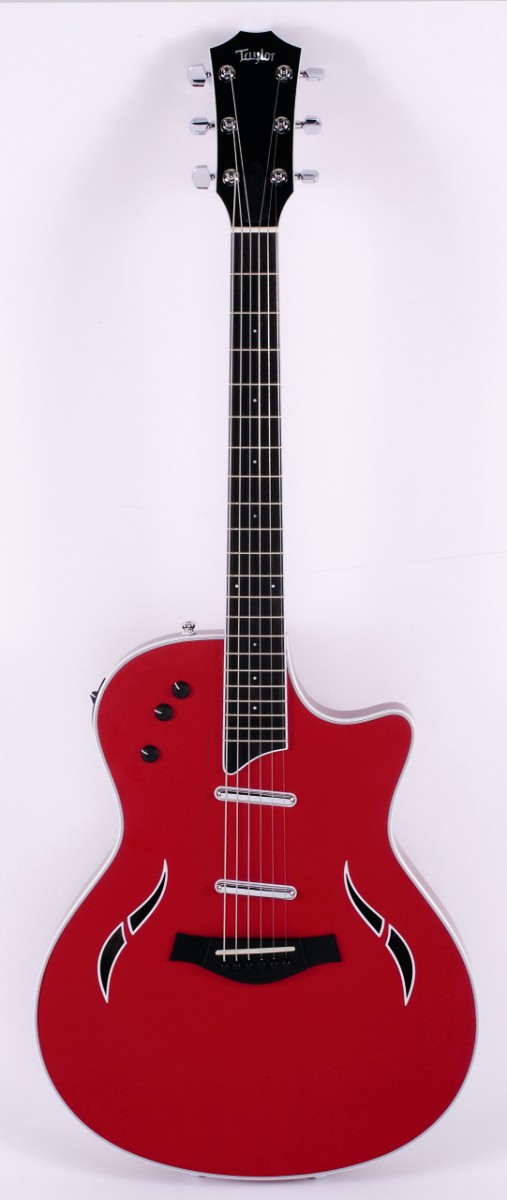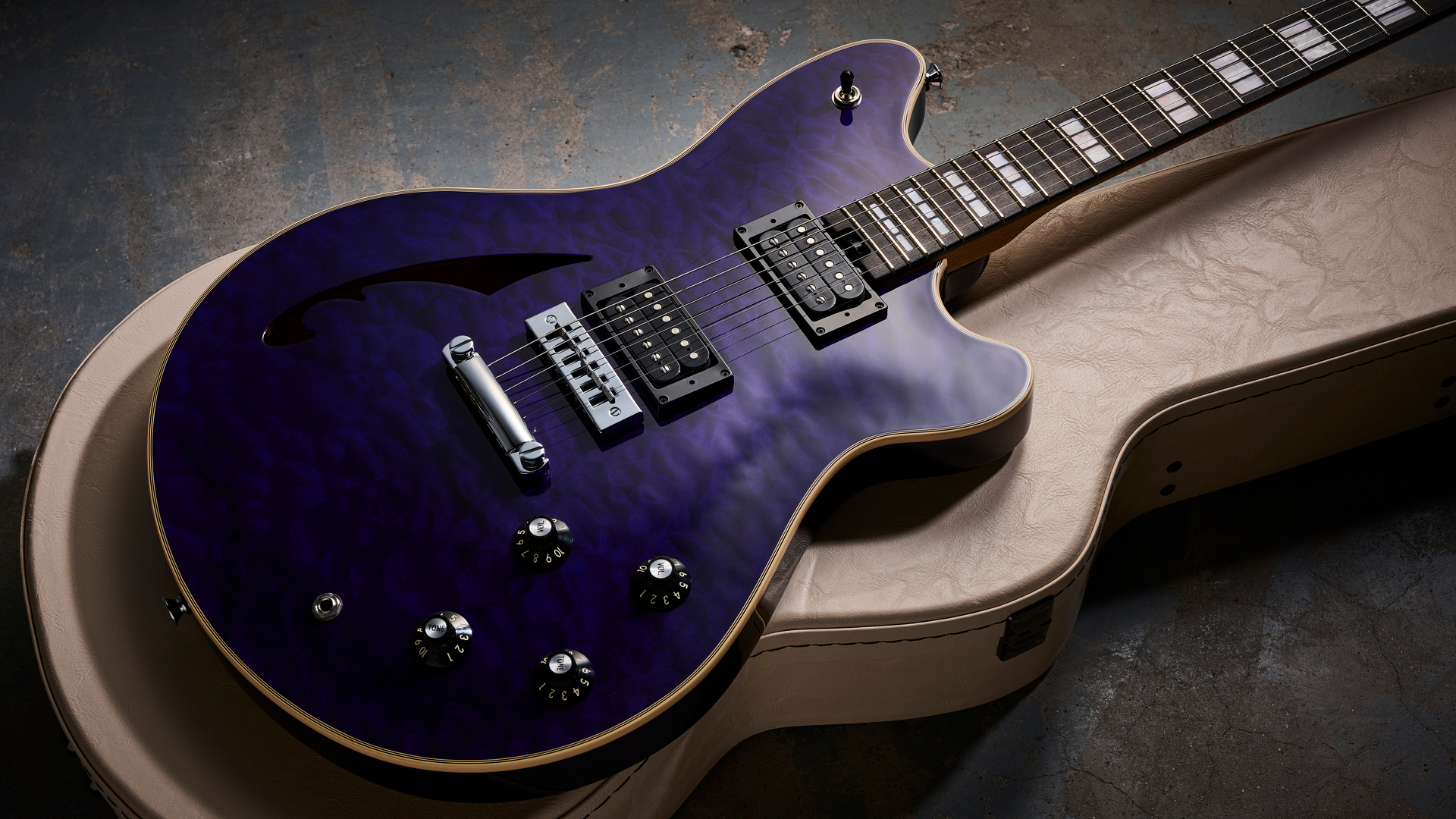MusicRadar Verdict
For the acoustic player wanting some electric tones, the T5 is the finest in its class.
Pros
- +
Superb build and design. Broad range of tones.
Cons
- -
Nothing, as long as you remember it's a hollow body and so at high volume/gain, you'll get feedback.
MusicRadar's got your back
It can now be ordered in a more electric format with two visible humbuckers. The guitar has taken on a life of its own - it has become Taylor's fastest-selling instrument ever.
It has its own factory within Taylor's San Diego base, it has won awards for both Best Acoustic and Best Electric, and last year Taylor made around 10,000 T5s - nearly as many instruments as an established electric maker like PRS makes in a whole year in the USA.
Another change in this year's T5 specification, along with the dual top-mounted humbucker option on the review guitar, is a choice of four solid metallic colours. It gives the T5 a less acoustic look and an almost retro vibe.
That's an 'almost' because Taylor just doesn't do vintage or retro in the least. Whereas a brand like PRS clearly revisits past glories in its designs, the T5 is solely modernistic. This is partly to do with the absolutely perfect construction, but also features like that ultra-white binding around the body, neck, head and the beautifully shaped soundholes.
Then there's the generic Taylor logo'd and chromed large-bodied and buttoned tuners, the micro-dot inlays, chromed pickup covers and the ultra-glossy, super-sheen finish. It's doubtful there will ever be a 'vintage' T5 with cream binding, Kluson-style tuners, nickel hardware and a lower-gloss finish, but hey, it's a nice thought.
Overview
Taylor's neck work is legendary for its precision, and on this guitar, both the neck shape - a beautifully smooth C-section profile - and clean fingerboard create an excellent player, even though the fret gauge (approx. 2mm wide x 1mm high) is smaller than most contemporary electrics.
The T5 introduced the new NT bolt-on neck joint to the Taylor camp that attaches the neck to body via a single Allen-keyed bolt. Typically, however, the first between neck and body is almost invisible and unlike many Fender bolt-ons, shows no desire to move sideways under generous pressure.
Initially, the T5's large cutaway body seems huge in comparison to an electric solidbody, but the hollow sapele back and sides, plus longitudinally braced spruce top illustrate its thinline electro-acoustic start point. It's not an acoustic - it's an electro, intended for the stage.
Of course, the additional top-mounted humbuckers provide the T5 with its 'electric' sounds. For this dual top-mount pickup version, we lose the body sensor of the 'single pickup' version, but retain the humbucking neck sensor, positioned out of sight in the heel joint under the fingerboard.
Mounted in a nicely designed bezel on the upper shoulder is an electric-style five-way lever switch that gives the following combinations of the three pickups: Position 1, the under-fretboard humbucker and neck humbucker in series; position 2, under-fretboard humbucker; position 3, bridge humbucker; position 4, bridge humbucker and under-fretboard humbucker in parallel; and position 5, bridge humbucker and under-fretboard humbucker in series.
This bezel also houses a red status LED for the 9V battery that powers the active preamp/EQ. According to Taylor it should last for about 40 hours. Then there's the three face-mounted, rubber-knobbed rotary controls - volume, bass and treble EQ - all of which are centre-notched.
Only the output jack, a standard passive jack on the guitar's side, leaves a little doubt after one reviewer turned up to a gig to find that a similar output jack had lost its nut and the socket had slipped inside the body. Fixing the chassis jack to a metal plate would prevent this potentially embarrassing problem occurring here.
Sounds
Despite the relatively shallow body, there's a good unplugged, acoustic-like tone and feel to the T5, and it has surprising volume too. Its five pickup selections all sound pretty 'acoustic' through an acoustic amp.
This dual pickup version loses perhaps the most acoustic-like body sensor, but even the hidden neck pickup (position 2) captures a full-toned, rich acoustic voice that's pleasantly darker than many electros, though still with acoustic-like crispness.
Indeed, any of the selections that voice this pickup sound very acoustic-like, and with the broad EQ, you can go from mid-scooped strum friendliness to an older mid-heavy voice that's more suited for blues and jazz or slide styles.
Through an electric amp, a good place to start is position 3 (bridge humbucker), which produces quite a bright, twangy tone with the EQs flat. Knocking off a little high end, either from the guitar or the amp, soon creates more electric-like accuracy.
There are some excellent rootsy or lo-fi tones to be had and again, experimenting with the EQ and volume is essential for coaxing the most useable tones. There's noticeable active background hiss and on more gained higher-volume tones, the guitar becomes a little uncontrollable. Like any semi, though, that's part of the fun.
A dual amp set-up really illustrates the potential. With only one set of onboard EQs, you have to make compromises and adjust each amp accordingly. Fairly obviously, more acoustic-like tones need some high-end crispness and the more electric tones need fewer highs and more mids.
However, get the balance right and this is a very expressive guitar that really can't be compared to many others on the market. It's a new sound - if that's possible - but above all, it's a new style of instrument to make your music with.
Dave Burrluck is one of the world’s most experienced guitar journalists, who started writing back in the '80s for International Musician and Recording World, co-founded The Guitar Magazine and has been the Gear Reviews Editor of Guitarist magazine for the past two decades. Along the way, Dave has been the sole author of The PRS Guitar Book and The Player's Guide to Guitar Maintenance as well as contributing to numerous other books on the electric guitar. Dave is an active gigging and recording musician and still finds time to make, repair and mod guitars, not least for Guitarist’s The Mod Squad.

“I need to build a sound of my own that has the power that I want”: Floating Points hates festival sound systems so much that he’s invented his own

“How daring to have a long intro before he’s even singing. It’s like psychedelic Mozart”: With The Rose Of Laura Nyro, Elton John and Brandi Carlile are paying tribute to both a 'forgotten' songwriter and the lost art of the long song intro

“I had a blast. Thank you”: Original Beatles drummer Pete Best retires, aged 83











